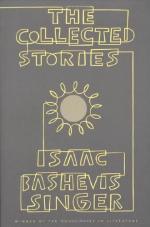|
This section contains 10,324 words (approx. 35 pages at 300 words per page) |

|
SOURCE: Whitfield, Stephen J. “Yentl.” Jewish Social Studies 5, nos. 1-2 (31 January 1999): 154-76.
In the following essay, Whitfield compares Singer's short story “Yentl the Yeshiva Boy” to Yentl, the film adaptation.
“Where is it written what it is I'm meant to be?”
This is the nearly monosyllabic question that Barbra Streisand sings in Yentl (1983) and that resonates throughout the film, which opens with the camera lingering over shelves of books. Her eponymous protagonist defies the rigidity of gender roles, as prescribed in the “Eastern Europe” of 1904, even as her query implicitly denies that her cherished texts prohibit study for females like herself. But Yentl indirectly gives another answer to her own question, which is that she need not be only what Isaac Bashevis Singer meant her to be. The cinema is different enough from books to honor its own aesthetic and historical imperatives; an art form that has its...
|
This section contains 10,324 words (approx. 35 pages at 300 words per page) |

|


